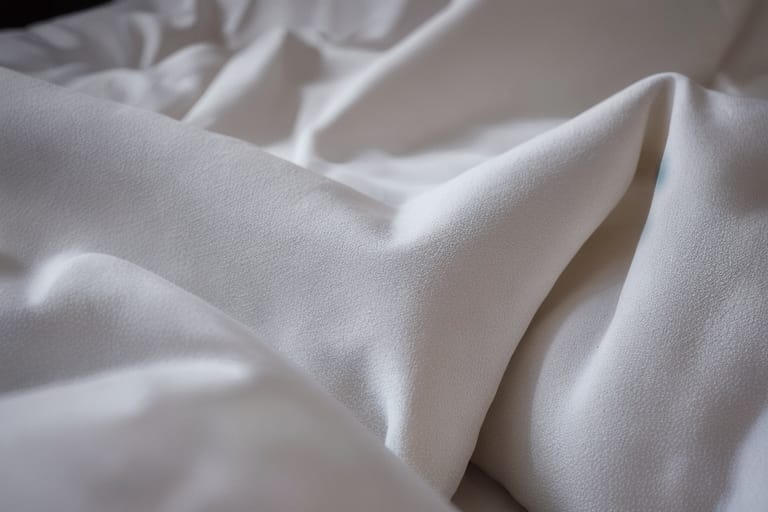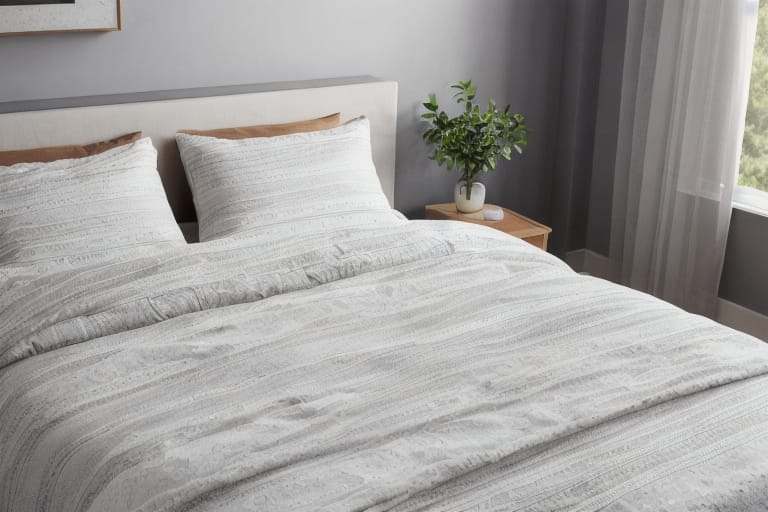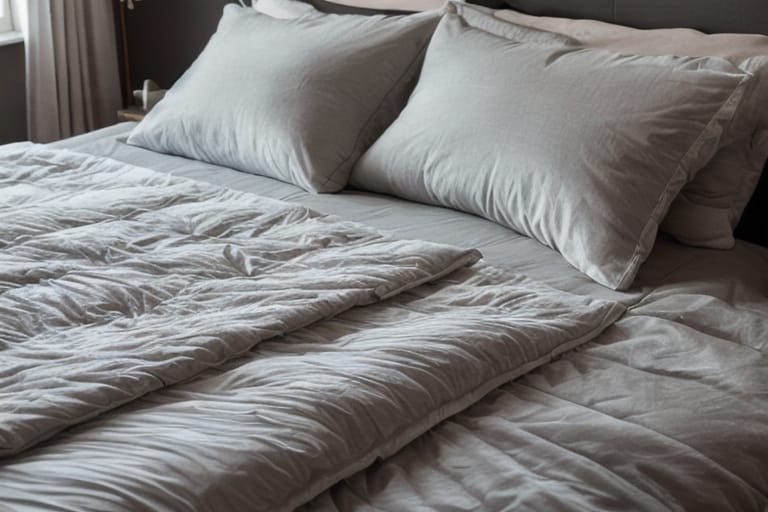Down comforters offer luxurious comfort and warmth, but sometimes washing them leaves behind unpleasant odors. If you’ve ever pulled your freshly laundered comforter out of the dryer only to be greeted by a musty, mildewy smell, you’re not alone. In this beginner’s guide, we’ll explore the reasons behind down comforter odors, provide tips for laundering and drying them properly, and share insights on preventing smells in the future. Get ready to enjoy a clean, fresh-smelling comforter once again!
Understanding Down Comforter Odors
First, let’s discuss the types of odors you might encounter and their common causes:
Types of Odors
- Musty or mildewy smell: Caused by moisture trapped in the comforter, allowing mold and mildew to grow.
- Sweaty or body odor: Resulted from accumulated sweat, body oils, and dead skin cells.
- Stale or dusty smell: Due to improper storage or infrequent cleaning.
Common Causes
- Moisture: Insufficient drying or storage in a humid environment.
- Bacteria: Thrives in warm, damp conditions and feeds on organic matter like sweat and skin cells.
- Improper storage: Storing comforters in non-breathable containers or humid areas.
Down comforter odors not only affect your comfort but can also harbor allergens and dust mites, potentially impacting your health.
Down Comforter Materials and Construction
To better understand how to care for your comforter, let’s look at its components:
Down Clusters and Fill Power
- Down clusters are the soft, fluffy plumage under a bird’s feathers.
- Fill power measures the loft and insulating ability of down. Higher fill power indicates better quality.
Outer Fabric
- Common materials include cotton, silk, and polyester blends.
- Fabric choice affects breathability, durability, and feel.
Baffling and Stitching
- Baffling keeps down evenly distributed and prevents clumping.
- Stitching patterns like box or diamond quilting secure the down.
The construction of your comforter influences its absorbency, breathability, and overall performance.
Washing Down Comforters
Proper washing technique is crucial to avoid damage and minimize odors:
Water Temperature
- Use cool or warm water, never hot, to prevent damaging the down.
- Follow care label instructions for specific temperature guidance.
Detergent Selection
- Choose a mild, low-sudsing detergent specifically designed for down.
- Avoid fabric softeners and bleach, which can strip down’s natural oils.
| Detergent Type | Benefits | Drawbacks |
|---|---|---|
| Down-specific | Gentle, retains loft | More expensive |
| Mild, low-suds | Affordable, readily available | May not clean as thoroughly |
Washing Machine Type
- Front-loading machines are gentler on down comforters due to less agitation.
- If using a top-loader, select a delicate cycle with minimal agitation.
Wash Cycles
- Use a delicate or gentle cycle with an extra rinse to remove all soap residue.
- For heavily soiled comforters, pretreat stains and use a regular cycle.
Drying Down Comforters
Proper drying is essential to prevent odors and maintain loft:
Tumble Drying vs. Air Drying
- Tumble drying on low heat helps fluff the down and removes moisture.
- Air drying takes longer but is gentler on the comforter. Ensure adequate ventilation.
Heat Setting and Drying Time
- Use low heat to avoid damaging the down clusters.
- Drying time depends on comforter size and machine capacity. Expect 2-3 hours.
Fluffing Techniques
- Add clean tennis balls or wool dryer balls to the dryer to help fluff the down.
- Pause the dryer periodically to manually fluff and redistribute the down.
| Comforter Size | Drying Time | Tennis Balls |
|---|---|---|
| Twin | 1-2 hours | 2-3 |
| Full/Queen | 2-3 hours | 3-4 |
| King | 3+ hours | 4-5 |

Preventing Odors During Storage
Proper storage helps maintain freshness between washes:
Ventilation and Air Flow
- Store comforters in breathable cotton bags or covered with a sheet.
- Avoid plastic containers, which trap moisture and promote odors.
Humidity Control
- Keep storage areas dry and well-ventilated to prevent mold and mildew.
- Use desiccants like silica gel packets to absorb excess moisture.
Periodic Maintenance
- Air out your comforter outdoors or in a well-ventilated room every few months.
- Fluff the down to maintain loft and distribute natural oils.
Treating Existing Odors
If your comforter already has an odor, try these remedies:
Natural Deodorizers
- Sprinkle baking soda on the comforter, let sit for several hours, then vacuum.
- Wash with a cup of white vinegar added to the rinse cycle.
Enzyme Cleaners
- Use an enzyme cleaner specifically designed for organic odors like sweat and oils.
- Follow product instructions for application and washing.
Professional Cleaning
- For persistent odors or delicate comforters, consider professional cleaning services.
- Look for cleaners experienced in handling down items.
Down Comforter Maintenance
Regular care prolongs the life of your comforter and keeps it smelling fresh:
Cleaning Frequency
- Wash comforters every 1-2 years, or more frequently if soiled or stained.
- Air out and fluff your comforter monthly to maintain freshness.
Stain Removal
- Address stains promptly to prevent setting and odors.
- Use a stain remover designed for down, following instructions carefully.
Protection from Wear
- Use a duvet cover to protect your comforter from body oils, sweat, and spills.
- Keep pets off the bed to minimize dander and accidents.
Choosing a Quality Down Comforter
Investing in a well-made comforter can make maintenance easier:
Fill Power and Down Quality
- Look for fill power of 600 or higher for optimal loft and insulation.
- Choose responsibly sourced, cleaned, and processed down.
Outer Fabric
- Opt for high-quality, tightly woven fabric with a thread count of 300+.
- Natural materials like cotton offer the best breathability.
Brand Reputation
- Research brands known for producing high-quality down comforters.
- Read customer reviews and compare warranties and return policies.
A quality down comforter can last 10-15 years with proper care, making it a worthwhile investment.
Conclusion
Down comforter odors can be frustrating, but understanding their causes and following proper laundering techniques can keep your comforter smelling fresh. Remember these key takeaways:
- Moisture, bacteria, and improper storage are common causes of odors.
- Use cool water, mild detergent, and gentle cycles when washing.
- Dry on low heat with tennis balls, fluffing periodically.
- Store in a breathable container in a dry, well-ventilated area.
- Address stains promptly and clean every 1-2 years.
By implementing these tips and investing in a quality comforter, you’ll enjoy a clean, fresh-smelling bed for years to come.

FREQUENCY ASKED QUESTIONS
- How often should I wash my down comforter? Wash your down comforter every 1-2 years, or more frequently if it becomes soiled or stained. Between washes, air out your comforter monthly to maintain freshness.
- Can I wash my down comforter in a regular washing machine? Yes, but use a front-loading washer if possible, as they are gentler on down. If using a top-loader, select a delicate cycle with minimal agitation. Always use cool water and a mild, low-suds detergent.
- How long does it take to dry a down comforter? Drying time depends on comforter size and dryer capacity. Expect 2-3 hours on low heat. Add clean tennis balls or wool dryer balls to help fluff the down, and pause the dryer periodically to manually redistribute the fill.
- What causes down comforters to smell after washing? Common causes include moisture trapped in the down, bacteria growth from improper drying, and storage in non-breathable containers or humid environments. Ensuring your comforter is thoroughly dry and stored properly can prevent odors.
- Can I use regular laundry detergent on my down comforter? It’s best to use a mild, low-suds detergent specifically designed for down. Regular detergents can strip the natural oils from down clusters and leave residue. Avoid fabric softeners and bleach, which can damage down.
- How do I remove odors from my down comforter without washing it? To freshen a comforter between washes, try sprinkling baking soda on the surface, letting it sit for several hours, then vacuuming. For spot cleaning, use a damp cloth and mild detergent solution, blotting gently.
- What should I look for when buying a quality down comforter?
Key factors include fill power (600+), down quality (responsibly sourced and cleaned), outer fabric (high thread count, natural materials), and brand reputation. A well-made comforter can last 10-15 years with proper care.








